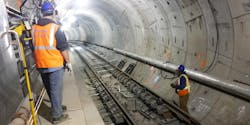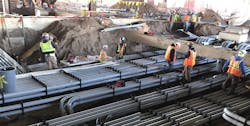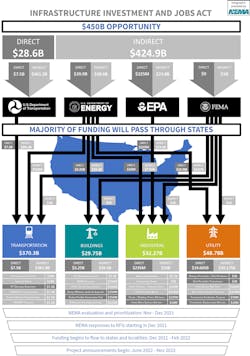After a long gestation and difficult birth, the Infrastructure Investment and Jobs Act (IIJA) became law on Nov. 15, 2021. Partisan wrangling is the obvious reason it took nearly eight months to go from conception to reality, but another is its unprecedented scope. The IIJA provides funding for just about every type of infrastructure, including water and wastewater treatment plants, transportation (such as rail and buses, roads, bridges, ports, and airports) as well as grid upgrades, renewables, and more. That means plenty of new business for electrical design firms and electrical contractors over the next several years.
“The infrastructure work we’d expect to see at Cupertino Electric would be related to our energy business, especially utility-scale renewable and battery storage projects,” says Tom Schott, president and CEO of the San Jose, Calif.-based firm. “On the public infrastructure side, we’d also be likely to see aviation, water treatment, and transit projects.”
The states and a variety of federal agencies — such as the Department of Energy and the Department of Transportation — oversee disbursing the money, with timelines varying by project type. In some cases, such as Federal Aviation Administration (FAA) facilities, the money will be “available until expended.” In others, it must be used by 2026 or 2028.
“It's going to be a bit of a bell curve,” says Phil Squair, vice president of government relations at the Arlington, Va.-based National Electrical Manufacturers Association (NEMA). “Some money is flowing now. Then it'll grow and grow. Most of the funding is probably going to go in years two, three, and four and then start to taper in years four and five.”
Ozone Park, N.Y.-based Five Star Electric has a similar outlook.
“I think a small portion of it [will be] in 2022, but I think it's going to have a larger impact over the following years — 2023, 2024, 2025 — especially with the magnitude and the size of the projects,” says Russ Lancey, president and CEO.
The White House’s “Building a Better America” guidebook, available at https://www.whitehouse.gov/build, spends 465 pages describing how, where, and when each dollar must be spent. (For perspective, that’s roughly half the length of the 2020 National Electrical Code.)
“A little over half of the money is going to flow to the states,” says Sarah Mathias, government relations director of the Arlington, Va.-based American Public Power Association (APPA), which represents community-owned utilities. “I've been trying to direct them to think about what projects they might have in the queue that could fit into these [IIJA-funded programs].”
$11 billion for grid modernization
One of the IIJA’s goals is grid modernization, which includes making it more resilient against natural disasters, demand spikes, and hackers.
“We expect significant investment in transmission, energy storage to enhance reliability, substations and distribution assets to support multi-direction energy flows, funds for system hardening in the face of aging infrastructure and climate change, and more,” says Marty Travers, executive director at Overland Park, Kan.-based Black & Veatch. “Additional opportunities will also exist for electrical engineering firms and electrical contractors who can support vehicle electrification infrastructure deployment funded by the IIJA.” For more information about IIJA funding for EV charging infrastructure, read the articles in our special EV section:
- “Electric Vehicle Infrastructure Buildout and the NEC” by Corey Hannahs
- “How to Support Safe EV Charging” by Jaska Tarkka and Lawrence Conner
- “Navigating the EV Evolution” by Rue Phillips
- “Is the Rise in EVs Cause for Electrical Safety Concern?” by Tommy Northcott
- “All About EV Charger (EVSE) Rebates” by Randy Young
- “New Semiconductor & EV Plants Expected to Fuel $130-Billion Construction Surge” by Jim Lucy
The $11 billion earmarked for grid modernization has three programs. One is “Preventing Outages and Enhancing the Resiliency of the Electric Grid,” which is funded at $5 billion and has some restrictions about how that money can be used.
“The list of what you can do with that is much longer than what you can't do,” says the APPA’s Mathias. “You can really do anything with that funding except construct new generation or large battery storage if it doesn't have sort of a disruptive event next to it. So, you can't do batteries for something else, or you can't do solar plus storage. But I think you could see a lot of folks obviously making an argument that they want to build battery storage for a resiliency purpose.”
Some contractors specializing in solar say that the IIJA doesn’t do much in terms of creating additional incentives. Instead, it will spur that market by, for example, funding transmission line expansions.
“That's a big one,” says Mike Seger, vice president for renewable energy at Fenton, Mo.-based Aschinger Electric, now part of Guarantee Electrical. “There are a lot of big, utility-scale solar and smaller community solar [projects] in rural areas that are held up because of transmission issues.”
Grid modernization also is an example of how the IIJA earmarks money for certain organizations.
“They set aside about 30% of the money for small utilities,” Mathias says, referring to the $5 billion outage prevention and resiliency enhancement program. “There's a lot of layers to this program. States can apply and have kind of a plan for their whole state-wide resiliency, which I think could be some bigger infrastructure.”
Old utilities (such as water) and new ones (such as broadband)
The IIJA also aims to upgrade drinking water and wastewater infrastructure. A lot of that work falls outside electrical, such as replacing lead pipes, but that still leaves ample opportunities, such as new pumping plants.
“Within the IIJA, the majority of the money coming into the water sector is through the existing clean water and drinking water state revolving funds (SRFs),” says Francesca McCann, business management director of the infraManagement Group, a wholly owned Black & Veatch subsidiary. “There’s $12 billion going each to clean water and drinking water SRFs.”
The IIJA also earmarks $65 billion for broadband. A big chunk is subscriber subsidies, but $42 billion is for the infrastructure itself. That’s an opportunity for electrical contractors who have expanded into the telecom market.
“That will be divided among states based on a formula, and those will be issued as subgrants that ultimately will be the path for that funding going to the contractors,” says Steve Truebner, a Black & Veatch director who oversees broadband projects. “NTIA, a sister agency to the FCC, will create parameters. Each state submits a five-year action plan and selects the right broadband deployment projects and partners.
“For electrical contractors, the funding that’s going to elevate their business is coming through the states. It’s anticipated that most of the infrastructure investment would ultimately be going to internet service providers, and they typically use internal and external contractors to perform the work. Because this is such a massive influx of capital, there’s an increased need for external contractors and partnerships to meet the expectations and the demand associated.”
Not so fast
It will take electrical engineers and contractors, as well as their clients, a while to navigate the IIJA’s myriad programs, funding formulas, timelines, and other nuances. That’s not necessarily a bad thing because it’s also going to take a lot of time — probably the better part of this year — to line up everything necessary to start work on IIJA projects.
“A lot of this information is still kind of coming out,” says the APPA’s Mathias. “How much of it flows out this year is a little bit of a question mark, at least in my mind.”
There are at least three major hurdles, starting with funding. President Biden signed a bill, not a check. That’s why on January 18 — two full months after the IIJA became law — the American Public Works Association (APWA) sent a letter to Congressional leaders urging them to fully fund the IIJA for the 2022 fiscal year. At press time in early March, Congress had not voted on IIJA funding.
“We had a [member] meeting last month in Texas, and one of the issues raised is that they're being confronted by mayors, councils, and county commissioners who say, ‘Let's get the money and start building,’” says APWA CEO Scott Grayson. “There is this misnomer out there that the money is all there and accessible, and it's not.”
So, for at least the next few months, the electrical industry will have to wait for disbursements to ramp up the bell curve that NEMA’s Squair referred to (see Infographic below for more information).
“Expect the full ramp-up of annual appropriations to take several years as new programs will have to be established to direct funding in several areas,” says Black & Veatch’s Travers. “In others, such as highway funding and certain transit elements, existing formulas determine the flow of money to the states.
“It’s also important to note that in many cases, the IIJA and the American Rescue Plan Act (ARPA) — passed in March 2021 — can be used in tandem to allow states and municipalities to pursue infrastructure projects without having to raise matching funds, historically a major barrier to project development at the state and local level. This opportunity could accelerate and expand the range of projects likely to move forward in 2022 and beyond.”
E-J Electric Installation Co. expects projects to start quickly once the money starts flowing.
“We see rapid deployment that will be required on many of these projects once fully funded,” says Anthony E. Mann, president and CEO of the Long Island City, N.Y.-based firm. “Our roads, bridges, and tunnels desperately need these upgrades and projects to improve our crumbling infrastructure. This tells us that safe, fast-track project delivery will be key. We are gearing up for many of these projects to be delivered utilizing alternative delivery methods including design-build and progressive design-build.”
Demand curve
Even if all the IIJA funds were disbursed today, a second major hurdle would stand in the way of many projects: a supply chain that’s already struggling to keep up with booming residential construction and a robust commercial sector.
“Challenges related to supply chain could be exacerbated by the ‘Buy America’ provision in the infrastructure bill,” says the infraManagement Group’s McCann. “Many of the components and equipment needed for water projects are not manufactured in the United States. Carveouts and waivers have yet to be determined. All of the issues that we’re facing could be heightened with this provision.”
For the past few years, some contractors have turned to reconditioned equipment as a way to keep projects on schedule. That could be an option for some IIJA-funded projects, too.
Equipment shortages also could drive up project costs, to the point that they exceed IIJA funding. The APWA warned the White House about that possibility in a meeting right before the bill was signed.
“I said, ‘We're excited about the passage of this bill and will help in any way, but we realize that the infrastructure is going to be a lot more expensive than was envisioned when this bill was being written,’” Grayson says.
Some are optimistic that supply will start to catch up with demand around the time when funding really starts flowing.
“From all the studies and the research I've done and what I can see, I think it starts to unclog toward the back end of this year and then hopefully gets back to some normalcy following that point,” says Five Star Electric’s Lancey.
The search for staff at every level
The third major hurdle might be the toughest: the chronic shortage of skilled labor. One potential option is using workforce service providers to quickly add people and support a major new project. Another is leveraging unions.
“There has definitely been a skilled labor shortage for field and also operations-type roles, such as project managers and engineers,” says Cupertino Electric’s Schott. “As a union contractor, we’re able to tap into the national labor force of the IBEW when we go into different areas, but not all areas have the same workforce capacity. Fortunately, we have a proven model to address these challenges that allow us to stand up and deliver large-scale projects on a national scale.”
Shortages also vary by region.
“The workforce shortage hasn't really been as large of a problem for us in this [Northeast] region when it was at its peak, before the pandemic,” Lancey says. “There was a bit of a shortage, as a union contractor, what they do is call in neighboring locals or neighboring geographic areas to bring in people. All in all, the labor workforce is okay at the moment.”
Some contractors see the IIJA as yet another reason to cast a wide recruiting net.
“I look holistically at what our industry can be doing to increase funding to help train and bring more women into the field,” says E-J Electric’s Mann, who is also a board member for Nontraditional Employment for Women (NEW). “I believe this is one of the many solutions to help with labor shortages. NEW actively prepares, trains, and places women in careers in the skilled construction, utility, and maintenance trades. This organization helps provide a pipeline of qualified workers to industries like ours that build, move, power, and maintain New York.”
Meanwhile, other sectors have their share of labor shortages, which affects how much money and people they can devote to IIJA projects.
“Public works [has a] real shortage,” Grayson says. “Whether it's public agencies, municipal and engineering firms, or contractors, [they all] have to raise salaries because there is this unusual market right now. When salaries are raised, the cost of goods and services go up exponentially. I'm still extremely positive about it, but we need to have our eyes wide open."
The states also must staff up to assess IIJA projects and then disburse funding. Hiring those people will take time.
“Some deem the overall process of SRF funding as cumbersome and slow anyway, and the additional funding will not speed up the process,” says the infraManagement Group’s McCann. “Some state SRF offices have their own labor challenges, too. If anything, because there’s potentially more demand for the money, it could end up creating a backlog for the states processing this.”
Federal agencies also have to add staff so they can help states and other entities.
“The Department of Energy is ramping up their guidance, but they're also hiring,” says the APPA’s Mathias. “I think they're going to try to hire a thousand people. They're [also] going to change some internal structure and create an office dedicated just to infrastructure. That is going to have a leader that is going to have to be confirmed by the Senate. I don't know if that slows things down or maybe slows things down in the short term, but ultimately speeds things up. There's just a massive amount of implementation that's going to have to happen.”
About the Author
Tim Kridel
Freelance Writer
Kridel is an independent analyst and freelance writer with experience in covering technology, telecommunications, and more. He can be reached at [email protected].





